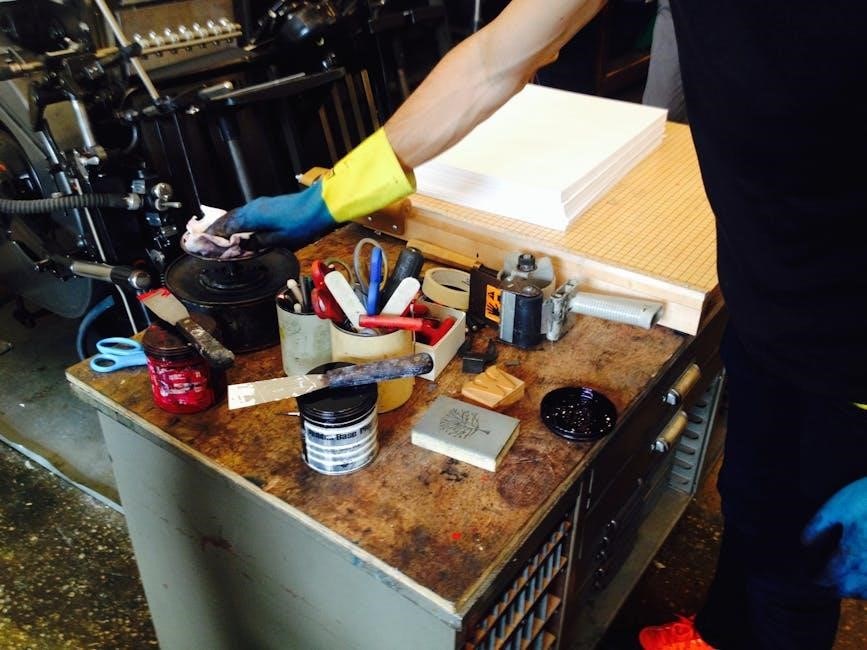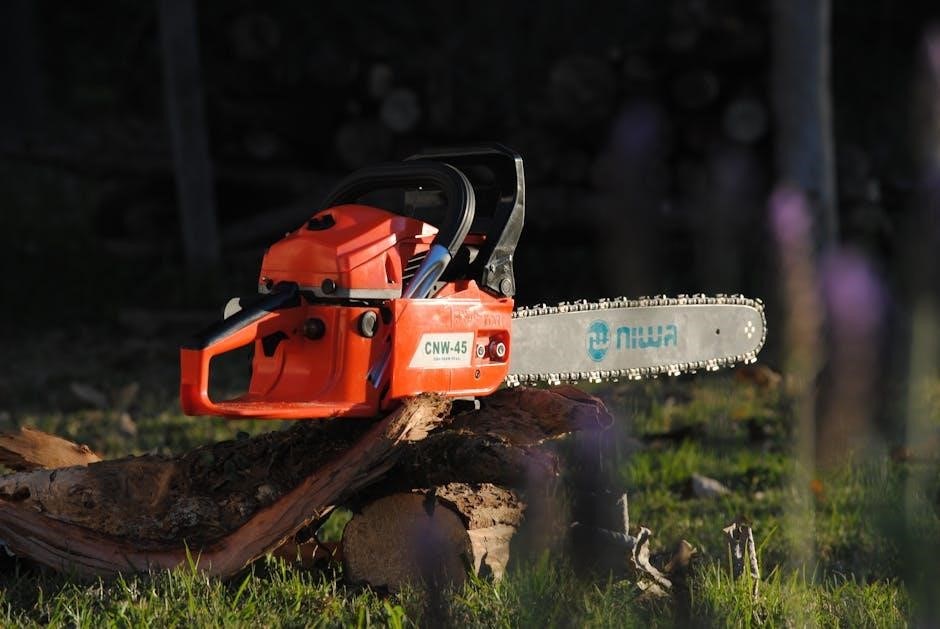Welcome to the Brush Cutter Manual! This guide provides essential information for safe and efficient operation. It covers key features, intended use, and proper maintenance procedures.
1.1. Purpose of the Manual
This manual is designed to familiarize users with the brush cutter’s features, operation, and maintenance. It provides detailed instructions for safe usage, troubleshooting, and proper care. The guide ensures users understand how to maximize efficiency while minimizing risks. By following the manual, users can operate the brush cutter effectively and maintain its performance over time. It also covers environmental considerations and best practices for responsible equipment use.
1.2. Key Features of the Brush Cutter
The brush cutter is equipped with a powerful engine and durable cutting attachments, including nylon cutters and steel blades. It features an ergonomic design for comfortable handling and reduced fatigue. The adjustable handle and anti-vibration system enhance user comfort. Additional features include a variable speed control and compatibility with various optional blades, allowing for versatile cutting tasks. These elements ensure efficient performance across different terrains and vegetation types.
1.3. Intended Use of the Brush Cutter
The brush cutter is designed for cutting grass, small bushes, and similar vegetation. It is suitable for maintaining lawns, clearing overgrown areas, and trimming around trees and fences. The tool is intended for professional and residential use, offering efficient cutting performance. Always use the appropriate cutting attachments for the task at hand. Follow the manual’s guidelines to ensure safe and effective operation, avoiding improper uses that could damage the device or pose safety risks.

Safety Precautions
Brush cutters can be dangerous if misused. Always wear protective gear, ensure the blade is free-moving, and keep bystanders at least 15 meters away. Avoid enclosed spaces to prevent carbon monoxide risks and ensure proper ventilation.
2.1. General Safety Warnings
Always follow all safety warnings to avoid accidents. Keep bystanders at least 15 meters away and wear protective gear, including gloves and eye protection. Never operate in enclosed spaces, as this can lead to carbon monoxide poisoning. Ensure the blade is free to move before starting the engine. Avoid modifying the brush cutter, as this can compromise safety. Keep children and pets away during operation. Proper ventilation is essential to prevent hazardous fumes.
2.2. Personal Protective Equipment (PPE)
Always wear appropriate PPE to minimize injury risks. This includes safety goggles, a face shield, gloves, and a helmet. Protective clothing like long pants and closed-toe shoes are also essential. Anti-slip boots improve stability while operating. Hearing protection is recommended for prolonged use. Ensure all PPE fits properly and is in good condition. Never operate without wearing the necessary protective gear, as debris or sharp blades can cause serious injury. Safety should always be the top priority.
2.3. Environmental and Usage Considerations
Operate the brush cutter responsibly to protect the environment. Avoid using it in ecologically sensitive areas like wetlands or nature reserves. Refrain from cutting near water sources to prevent contamination. Use the appropriate blade for the task to minimize waste. Dispose of cut debris and worn parts properly. Follow local regulations regarding emissions and noise levels. Always maintain the unit to reduce fuel consumption and emissions, ensuring efficient and eco-friendly operation.

Understanding Your Brush Cutter
Understand your brush cutter’s components, features, and capabilities. Familiarize yourself with its engine, shaft, and cutting attachments. This knowledge ensures safe and effective operation for various tasks;
3.1. Components of the Brush Cutter
The brush cutter consists of three major units: the engine, flexible shaft, and drive shaft. The engine powers the machine, while the shafts transmit power to the cutting attachment. Additional components include the cutting blade or nylon cutter, D-handle for control, and debris shield for protection. Understanding each part’s function ensures proper assembly, operation, and maintenance, maximizing efficiency and safety during use;
3.2. Types of Brush Cutters
Brush cutters are available in various types, including petrol-powered and electric models. Petrol cutters offer higher power and portability, ideal for large areas. Electric models are lighter and eco-friendly, suitable for smaller tasks. Some units come with interchangeable attachments, allowing use as trimmers or saws. Choosing the right type depends on terrain, vegetation thickness, and personal preference, ensuring efficient cutting and ease of use for diverse applications.
3.3. Cutting Attachments and Blades
Cutting attachments and blades are crucial for efficient operation. Common options include nylon cutters for trimming grass and metal blades for thicker vegetation. Blades vary in size and type, such as circular or serrated edges, depending on the task. Always use the correct attachment for the job to ensure safety and performance. Regularly inspect and replace worn or damaged blades to maintain cutting efficiency and prevent accidents during use.

Assembly and Initial Setup
Unpack and inventory all components. Assemble the drive shaft and attach the cutting blade. Follow manual instructions for proper setup to ensure safe and efficient operation.
4.1. Unpacking and Inventory
Begin by carefully unpacking the brush cutter and all included accessories. Check the inventory list to ensure all components are present. Verify the condition of each part, including the drive shaft, cutting blade, handle, and safety gear. Ensure no items are damaged or missing. Familiarize yourself with the contents before proceeding to assembly. This step is crucial for a smooth setup process and proper functionality of the brush cutter. Refer to the manual if any parts are unclear or missing.
4.2. Assembling the Drive Shaft
Insert the flexible shaft into the drive shaft housing, ensuring proper alignment. Secure the connection using the provided screws or clips; Tighten firmly to avoid loose parts during operation. Refer to the manual for specific torque settings. Once assembled, test the drive shaft for smooth rotation and stability. Make sure all connections are secure before proceeding to attach the cutting blade. Proper assembly ensures efficient power transfer and safe operation of the brush cutter.
4.3. Attaching the Cutting Blade
Place the blade on the spacer, aligning the center hole with the drive shaft. Secure with the washer and retaining bolt. Tighten the bolt clockwise until snug. Ensure the blade is free from obstructions and properly balanced. Refer to the manual for torque specifications. Double-check the blade guard is in place for safety. Once attached, test the blade’s rotation before use to ensure it operates smoothly and safely. Proper attachment is crucial for effective cutting performance and operator safety.

Operating the Brush Cutter
Operate the brush cutter safely and efficiently by following proper techniques. Start the engine, engage the blade, and cut evenly. Adjust speed for terrain and vegetation.
5.1. Starting the Engine
To start the engine, ensure the brush cutter is on level ground. Prime the engine by pressing the primer bulb 2-3 times until fuel flows. Move the choke to the “start” position and pull the starter rope firmly until the engine ignites. Allow the engine to warm up for a few seconds before adjusting the choke to the “run” position. Ensure the cutting blade stops moving before walking or transporting the unit.
5.2. Basic Cutting Techniques
Start by cutting in a swath pattern, moving from left to right. Use the tip of the blade for efficient cutting, as it maintains maximum cutting power. Keep the brush cutter at a slight angle to avoid throwing debris. For taller vegetation, cut in sections, working from the top downward. Always maintain control and balance, adjusting your stance and blade angle based on terrain and vegetation thickness. This ensures safe and effective cutting performance.
5.3. Handling Different Terrains
Adjust your technique based on terrain type. On flat ground, maintain a steady pace and keep the blade at a consistent angle. For slopes, cut uphill to avoid slipping and loss of control. On uneven surfaces, proceed slowly and avoid sudden movements. In dense vegetation, use a slower, more deliberate motion to prevent clogging. Always keep the brush cutter balanced and use the variable speed control to optimize performance in challenging areas.
5.4. Using Variable Speed Control
The variable speed control allows you to adjust the cutting head’s RPM according to the task. For light grass, use a lower speed to conserve fuel. Increase speed for thicker vegetation or tougher weeds. Adjust on-the-go to maintain efficiency without overloading the engine. Proper speed control ensures optimal performance, reduces wear, and enhances safety. Always refer to the manual for specific guidelines on speed settings for different cutting applications and terrains.

Maintenance and Care
Regular maintenance ensures longevity and performance. Clean the cutter after use, lubricate moving parts, and check for wear. Store properly to prevent damage and rust.
6.1. Daily Pre-Use Checks
Before each use, inspect the brush cutter thoroughly; Check the blade for damage or wear and ensure all bolts and screws are tightened. Verify the fuel level and oil condition. Inspect the air filter and spark plug for cleanliness and proper function. Ensure the cutting head rotates freely and all safety guards are in place. Address any issues immediately to prevent accidents and maintain efficiency during operation. Regular checks help extend the tool’s lifespan and ensure safe usage.
6.2. Cleaning and Lubrication
Regular cleaning and lubrication are crucial for maintaining your brush cutter’s performance and longevity. After each use, clean the air filter, blade, and outer casing to remove debris. Lubricate moving parts, such as the drive shaft and cutting head, to reduce friction and wear. Apply rust-inhibiting oil to metal components to protect against corrosion. Always refer to the manual for specific lubricant recommendations and procedures to ensure optimal maintenance.
6.3. Replacing Wear Parts
Regularly inspect and replace worn or damaged parts to ensure optimal performance. Blades, trimmer heads, and drive shaft components are common wear parts that may need replacement. Always use genuine or compatible parts for longevity. After replacing, lubricate moving parts to maintain smooth operation. Refer to your manual for specific replacement steps and guidelines to ensure safety and efficiency during the process.
6.4. Storage and Transportation
Store the brush cutter in a dry, well-ventilated area away from direct sunlight. Cover the unit to protect it from dust and moisture. During transportation, secure the cutter firmly to prevent movement and damage. Ensure the fuel tank is empty or properly sealed to avoid leaks. Always follow local regulations for transporting fuel-powered equipment. Proper storage and transport practices help maintain the unit’s condition and ensure safety.

Troubleshooting Common Issues
This section helps diagnose and resolve issues like engine failure, poor cutting performance, and excessive vibration. Follow the guidelines to identify and fix problems effectively.
7.1. Engine Not Starting
If the engine fails to start, check the fuel level and ensure the tank is not empty. Verify that the choke is in the correct position and the air filter is clean. Additionally, inspect the spark plug for wear or fouling and replace it if necessary. Consult the manual for specific troubleshooting steps tailored to your brush cutter model to resolve the issue efficiently.
7.2. Poor Cutting Performance
Poor cutting performance can result from a dull or damaged blade, incorrect blade type for the task, or improper machine setup. Ensure the blade is sharp and suitable for the vegetation type. Check for debris accumulation on the cutter head and clean it thoroughly. Verify that the cutting wire tension is optimal for efficient operation. Adjusting your technique, such as maintaining a steady pace and proper angle, can also enhance performance. Consult the manual for specific blade recommendations and troubleshooting tips.
7.3. Vibration or Noise
Excessive vibration or unusual noise can indicate issues like an unbalanced blade, loose components, or worn-out parts. Inspect the cutting blade for damage or imbalance and replace it if necessary. Tighten all bolts and screws to ensure stability. Lubricate moving parts regularly to reduce friction and noise. If the problem persists, check for misaligned or damaged drive shafts and seek professional assistance. Proper maintenance can help minimize vibration and ensure smooth operation.

Accessories and Attachments
Explore a variety of optional blades, safety equipment, and compatible tools to enhance your brush cutter’s functionality and safety.
8.1. Optional Blades and Cutters
Optional blades and cutters are available to suit different cutting tasks. Choose from nylon cutters for grass or metal blades for thick vegetation. Ensure compatibility with your brush cutter model for optimal performance. Always follow safety guidelines when replacing or using these attachments. Proper selection enhances efficiency and safety, ensuring your tool adapts to varying conditions effectively.
8.2. Additional Safety Equipment
Additional safety equipment is crucial for protecting the operator and bystanders. Wear approved gloves, helmets, eye protection, and anti-slip boots. Use a face shield for extra protection against debris. Ensure the blade guard is securely attached to prevent accidental injuries. Keep children and pets at least 15 meters away during operation. Proper safety gear reduces risks and ensures a safer working environment while using the brush cutter.
8.3. Compatibility with Other Tools
Your brush cutter may be compatible with various attachments, enhancing its versatility. Optional blades like nylon cutters and metal blades can tackle different tasks. Some models allow attaching grass trimmer heads or edging tools. Ensure all accessories are approved by the manufacturer to maintain safety and performance. Compatibility varies by model, so consult your manual for specific recommendations to maximize your brush cutter’s functionality and efficiency in diverse cutting scenarios.

Safety During Maintenance
Safety during maintenance is critical. Always wear approved gloves, safety glasses, and ensure the machine is off. Be cautious of sharp edges and hot engine parts. Adhere to all safety guidelines to prevent accidents and ensure proper maintenance.
9.1. Precautions Before Servicing
Before servicing, ensure the brush cutter is turned off and allowed to cool. Wear protective gloves, safety glasses, and ensure the blade is stationary. Disconnect the spark plug to prevent accidental starting. Keep the area well-ventilated to avoid carbon monoxide exposure. Never service the machine in enclosed spaces or near open flames. Be cautious of sharp edges and moving parts. Always refer to the manual for specific instructions to ensure safety and proper maintenance procedures.
9.2. Safe Handling of Sharp Parts
Always wear gloves and eye protection when handling sharp parts like blades or cutters. Avoid touching sharp edges to prevent injury. Use tools to handle blades, and ensure the machine is turned off. Store sharp parts securely to avoid accidents. Regularly inspect blades for damage and replace them if necessary. Properly dispose of worn or damaged parts to prevent hazards. Follow the manual’s guidelines for safe handling to maintain operator safety and equipment integrity.
9.3. Proper Disposal of Waste
Dispose of waste materials like old blades, packaging, and chemicals responsibly. Separate metal and plastic parts for recycling. Check local regulations for hazardous waste disposal. Do not discard sharp or hazardous materials in regular trash. Use sealed containers to prevent environmental contamination. Follow the manufacturer’s guidelines for disposal of fuel, oil, and other liquids. Proper disposal helps protect the environment and ensures compliance with local laws and safety standards. Always prioritize eco-friendly practices when managing waste from your brush cutter.

Environmental Considerations
Adopt eco-friendly practices to minimize environmental impact. Use correct fuel types to reduce emissions. Avoid spills and ensure proper waste disposal. Protect water sources from contamination and adhere to local regulations for sustainable practices.
10.1. Responsible Usage Practices
Responsible usage practices are crucial for environmental conservation. Always use the brush cutter for its intended purposes, such as cutting grass and small bushes. Avoid using it in sensitive ecosystems or near water sources to prevent contamination. Ensure proper handling of fuel to minimize spills. Regular maintenance can reduce emissions and prolong the life of the equipment. Proper disposal of waste materials, like old blades and fuel, is essential. By following these guidelines, users can contribute to a healthier environment while maintaining efficiency.
10.2. Fuel and Emission Guidelines
Adhere to fuel and emission guidelines to ensure eco-friendly operation. Use recommended fuel types to minimize emissions and maintain performance. Regularly check for fuel spills and leaks to prevent environmental contamination. Follow local regulations regarding emission standards. Properly maintain the engine to reduce exhaust emissions. Always dispose of used fuel and filters responsibly. By following these guidelines, you can contribute to reducing the environmental impact of your brush cutter while ensuring optimal functionality and compliance with environmental laws.
10.3. Proper Disposal of Old Units
Properly dispose of old brush cutter units to protect the environment. Separate metal and plastic components for recycling. Drain all fluids, including fuel and oil, and dispose of them according to local regulations. Remove batteries and other hazardous materials responsibly. Do not dispose of the unit in landfills. Contact local recycling centers or authorized dealers for guidance. Ensure all sharp parts are safely packaged to prevent injury during disposal. Responsible disposal helps reduce environmental impact and conserve resources.